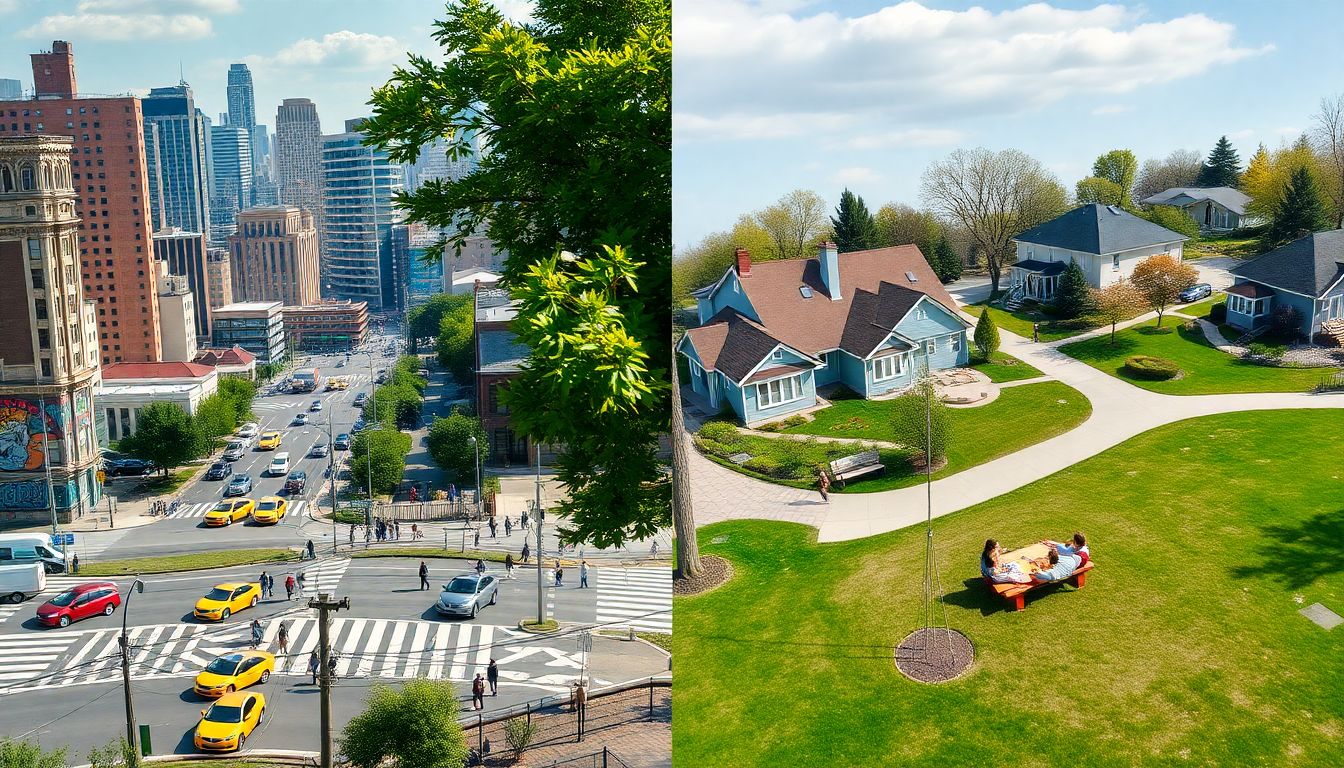Urban vs. Suburban Living: Which Lifestyle Suits You Best?
Stuck between the bright lights and the quiet streets? Can't decide if you should embrace the city's hustle or settle into the suburbs' calm? You're not alone. Many people face this tough choice.
Urban living means residing in a city. Think skyscrapers, bustling streets, and diverse cultures. Suburban living involves living in the areas surrounding a city. It typically offers more space, quieter neighborhoods, and a slower pace.
Choosing where to live greatly affects your happiness. It changes your daily life and impacts your future.
This article breaks down urban and suburban living. We will explore their ups and downs. We aim to give you clear insights. This will help you choose what fits you best. No matter your preferences, you can find a place that you will love!
Cost of Living: Balancing Affordability and Amenities
Money matters a lot when picking a place to live. City living and suburban life come with different price tags. Understanding these costs is key. It helps you make a smart choice for your wallet.
Housing Costs: Rent vs. Mortgage
City rent can be very expensive. You often pay more for less space. Suburban houses may be larger. Mortgages, property taxes, and other fees need consideration.
In cities, expect to pay top dollar for apartments. Space is often limited. Suburbs may offer bigger houses. Remember to factor in mortgage payments and taxes. Also, think about commuting costs. They can affect your overall housing budget.
Transportation Expenses: Cars vs. Public Transit
Cars are often a need in the suburbs. This means car payments, insurance, and gas. Cities often have great public transportation. Buses, trains, and subways can save you money.
Suburbs usually mean car ownership. This adds up with gas and upkeep. Cities provide various public transit options. Think about monthly passes for savings.
Everyday Expenses: Groceries, Entertainment, and Services
Daily costs also vary. Cities might have pricier groceries. Entertainment can be cheaper, with many free events. Suburbs could offer cheaper groceries. Eating out and entertainment might require travel.
City living has higher grocery prices. Many free or cheap activities exist. Suburban groceries are usually less. Traveling for fun can increase costs. Also, local taxes matter. They affect your spending power.
Career and Education: Opportunities and Accessibility
Where you live impacts your career and education. Cities and suburbs offer different advantages. Consider your job and schooling when deciding where to live.
Job Market: Industry Clusters and Commuting Distance
Cities often have many jobs in certain fields. Suburbs may offer remote work options. Think about commute times. Long commutes can impact work-life balance.
Urban areas often have many jobs. Consider finance in New York. Suburbs can offer telecommuting. How long will you travel to work?
Educational Institutions: Schools, Colleges, and Universities
Cities usually have diverse schools and colleges. Suburbs may have highly-rated public schools. Think about specialized programs. Also, look at after-school activities.
Cities may feature specialized programs. Suburbs can offer excellent schools. What about sports or music programs?
Networking and Professional Development
Cities are great for networking. You'll find conferences and meetups. Suburbs offer local business groups. Each provides ways to grow professionally.
Cities provide chances to meet others. Suburbs have local groups. Both support your career.
Lifestyle and Community: Finding Your Tribe
Your surroundings influence your lifestyle. Cities and suburbs offer different social experiences. Where do you belong?
Social Scene: Diversity vs. Homogeneity
Cities are known for diversity. You'll meet people from everywhere. Suburbs can be more uniform. This affects social experiences.
Cities mix different people. Suburbs can be more alike. Think about your daily interactions.
Community Engagement: Local Events and Volunteer Opportunities
Cities have many events and volunteer chances. Suburbs offer local community activities. Both provide ways to get involved.
Cities host many festivals and gatherings. Suburbs feature local events. You can help out in both places.
Access to Amenities: Parks, Recreation, and Entertainment
Cities offer museums, restaurants, and parks. Suburbs have parks, malls, and family spots. Each lifestyle caters to different interests.
Cities provide easy access to culture. Suburbs offer family-friendly places. Think about your leisure activities.
Safety and Security: Perceptions and Realities
Safety is a key factor when choosing a home. Cities and suburbs present different safety concerns. Knowing the facts helps you feel secure.
Crime Rates: Urban Challenges vs. Suburban Concerns
Cities face more property crime. Suburbs might deal with burglaries. Population density matters. Socioeconomic factors also affect safety.
Cities struggle with theft. Suburbs have issues with home break-ins. Where do you feel safest?
Environmental Factors: Pollution and Noise Levels
Cities often have more pollution and noise. Suburbs may offer cleaner air. Consider your health and peace of mind.
Cities struggle with air pollution. Suburbs often offer quieter areas. How do you feel about these?
Community Watch Programs and Security Measures
Cities and suburbs have watch groups. Neighborhood groups boost safety. These efforts create safer communities.
Both cities and suburbs offer watch programs. Groups can protect your area. They promote safety and security.
Conclusion
Urban and suburban living present distinct paths. Cities offer energy and diversity. Suburbs provide peace and space.
Your values and priorities should guide you. Think about what matters most to you. Consider your needs and preferences.
Evaluate housing, jobs, lifestyle, and safety. No single answer fits everyone. Your ideal place depends on your unique life. Consider what makes you happy. Choose wisely!
